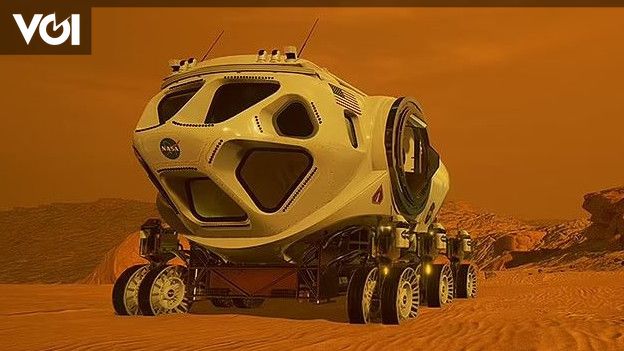JAKARTA – The idea of living and colonizing a planet on Mars may sound like the plot of the latest sci-fi blockbuster. But outside numbers companies like NASA and SpaceX are seriously considering it a possibility.
Even the world conglomerate and owner of SpaceX, Elon Musk, has invited citizens of +62 aka Indonesia to live on Mars. Could this be a joke or serious. But there are a few things to note given the many challenges of living on Mars.
Several challenges currently stand in the way of living on Mars, including building self-contained spacecraft that can safely carry crews, and finding ways to protect astronauts from harmful solar and cosmic radiation. Not to mention allowing them to live in microgravity on a planet without an atmosphere.
This week, Lord Martin Rees, one of the country’s leading astronomers, claimed that the obvious solution to some of these problems would be to make future explorers part of the world. cyborg.
“These intrepid explorers on Mars will come out of the grip of regulators and they will have every incentive to modify themselves because they are so poorly adapted to Mars,” Lord Rees told the Hay Festival.
“They will use all these techniques to adjust. In a generation or two they could become very different species,” added Lord Reeds.
“We don’t know what mixture they will make from flesh and blood and electronics, but if they become electronic then of course they can approach eternity. If that is the problem, they will be able to travel a very long interstellar journey, hibernating for thousands of years, “he added.
Maybe becoming a cyborg is the right move for the Martians of the future because they can solve several problems at once.
Survive in Microgravity
One of the biggest challenges for human colonists is staying fit and healthy on Mars. Research has shown that the transition from one gravitational field to another can affect spatial orientation, head-eye and hand-eye coordination, balance and locomotion. Astronauts also experience bone and muscle changes in space.
“In addition, fluid in the body shifts upward to the head in a micro -weight style, which can put pressure on the eyes and cause vision problems,” NASA added.
“If precautions or countermeasures are not implemented, crew members may be at increased risk of developing kidney stones due to dehydration and increased excretion of calcium from their bones,” NASA added.
–
–
NASA is looking at several ways to keep astronauts healthy during missions to Mars, including artificial gravity devices and vibration platforms to help regenerate bones and muscles. Becoming a cyborg can be beneficial in helping counter the effects of microgravity on the human body.
For example, humans can be fitted with iron lungs or steel plates under the skin to protect our soft organs and make us more resistant to the effects of microgravity.
Adapting to Mars’ Climate
Because Mars is farther from the sun, temperatures there are much colder than on Earth. On the Red Planet, temperatures can drop as low as -200°F (-128°C). In comparison, the lowest temperature on Earth is -128.6°F (-88°C).
Luckily, NASA’s next-generation spacesuit, launched in 2019, is designed to withstand extreme temperatures, and will help keep settlers warm.
“The suit is made to withstand extreme temperatures of -250°F [-156 °C] in the shade and up to 250 ° F [121 °C] in the sun,” NASA said.
Cyborgs can have similar technology implanted in their bodies, or in the form of exoskeletons – although the NASA spacesuit would offer a good alternative for those hoping to remain fully human!
Breathe on Mars
Reported by Daily Mail, Mars’ atmosphere is very thin and is dominated by carbon dioxide. “To people on Earth, it is a toxic gas at high concentrations,” explained Dr. Phylindia Gant and Amy Williams, geologists from the University of Florida, in an article in The Conversation.
“Fortunately, it makes up far less than one percent of our atmosphere. But on Mars, carbon dioxide is 96 percent of the air!” he added.
As a result, if humans tried to breathe on Mars without any protection, they would instantly suffocate. Luckily, the NASA spacesuit has a Portable Life Support System installed to ensure this doesn’t happen.
“A Portable Life Support System is a backpack that astronauts wear on space travel that accommodates the strength and breathable air of the garment and removes exhaled carbon dioxide and other toxic gases, odors and moisture from the clothing,” NASA said in a statement.
It also helps regulate the temperature and monitor the overall performance of the setting, emitting alerts if the power source drops, or if there is a system failure.
Miniaturization of electronics and piping systems has made it possible to build duplicates for most systems, making some failures less of a concern.’
Like surviving cold temperatures, being a cyborg could make breathing on Mars easier without assistance. For example, cyborgs can somehow have permanent breathing apparatus inserted into their bodies that filters out CO2 and provides oxygen to the body.
So, are you still interested in living on Mars like Elon Musk’s invitation? Just be ready with all the obstacles and obstacles and the tools needed.
–


